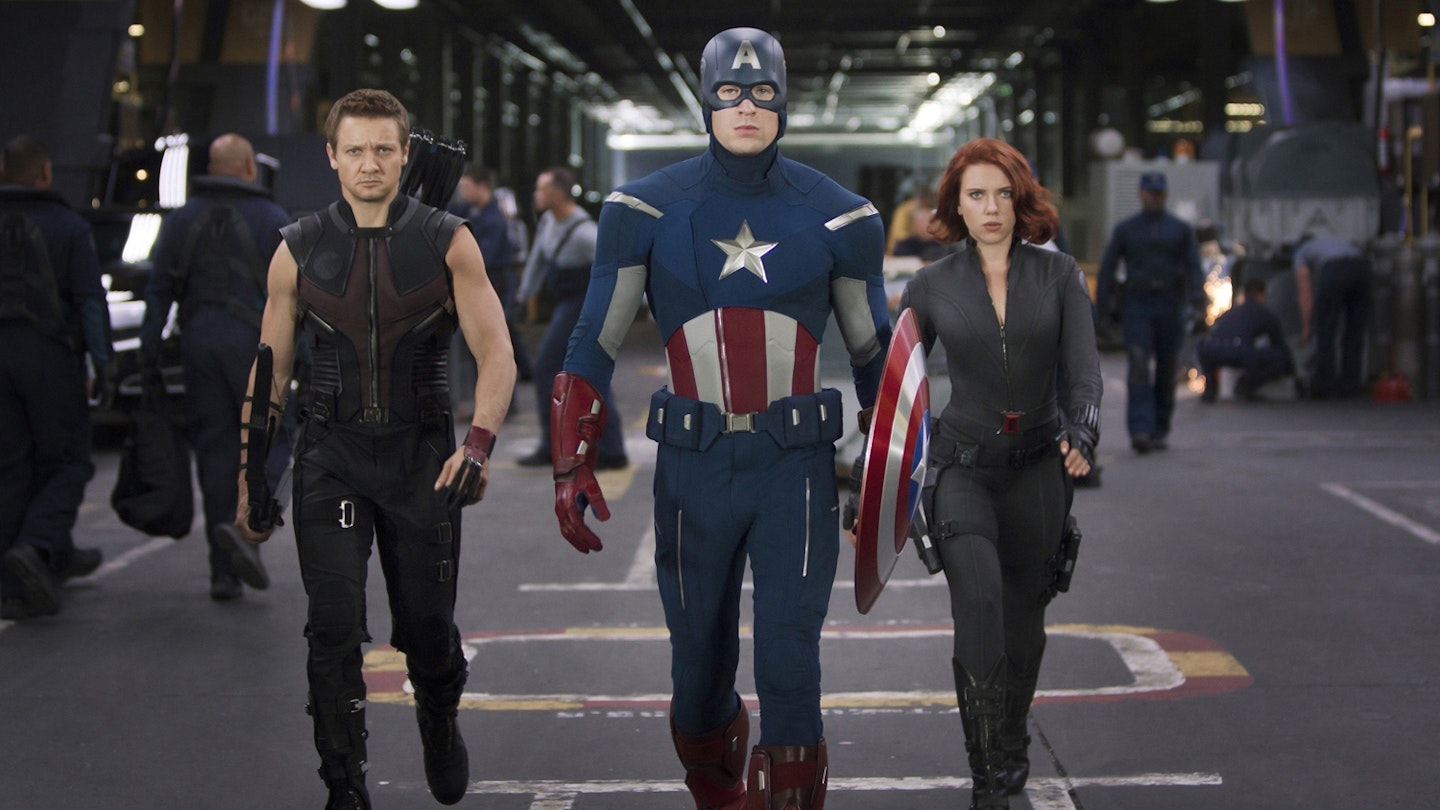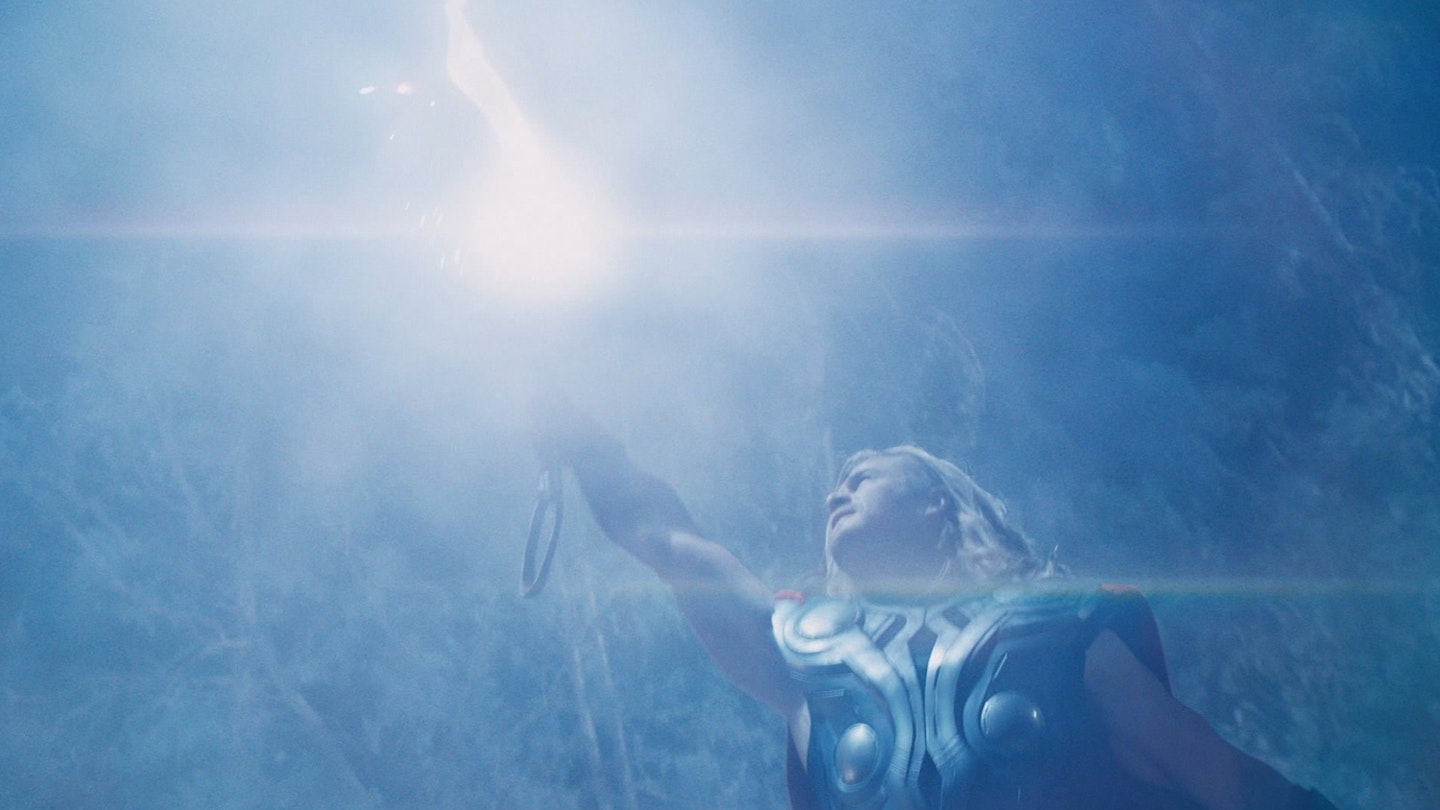It’s 2012. You’re sat in the biggest cinema screen you could find, up to your eyes in sweet and salted popcorn (the very best kind). You’ve just watched Mark Ruffalo’s Bruce Banner rock up to join several other caped and costumed pals in New York, delivering that line (“That’s my secret, Cap. I’m always angry.”) before turning green and punching the massive Chitauri Leviathan in the face. The camera pans to a roaring Hulk, then rotates in a circle around Hawkeye (Jeremy Renner) putting an arrow to his bow, Thor (Chris Hemsworth) raising his hammer, Black Widow (Scarlett Johansson) reloading her gun, Captain America (Chris Evans) adjusting his shield, and Iron Man (Robert Downey Jr) floating down to join them. Alan Silvestri’s score swells as you see all six heroes in one place, in one shot, in one film. We’re not saying it’s the best moment of your life (so far – there are a few years to go until Cap lifts Mjolnir, after all), but we’re not not saying that, either.
The Avengers wasn’t the first film to give us a collective of superheroes to root for: the X-Men and Fantastic Four movies were doing it long before Nick Fury (Samuel L. Jackson) got the idea to put a team together. But when Marvel Studios began producing their own films independently, they did it a little differently – where X-Men and Fantastic Four were ensemble stories from the start, the MCU established Cap, Iron Man, Thor and (even though Edward Norton was recast) The Incredible Hulk as protagonists in their own right, carrying their own solo movies (and, in Iron Man’s case, a sequel), before uniting them in what was, at that point, the biggest crossover event in cinematic history.

It’s a plan that Marvel’s head honcho Kevin Feige had from the get-go, back when he was appointed as the studio’s President of Production just as the wheels on the first Iron Man were starting to turn – and one that played heavily into their strategy for Phase One. “We ordered the release of the films, purposefully, because we knew we wanted audiences to be familiar with the heroes first,” Feige told Empire, for our The Avengers cover feature in the March 2012 issue. “I was hoping that, by the end of the summer, people would be debating which one is their favourite.”
As Ruffalo’s Banner says, the Avengers are “not a team, we’re a timebomb”, and The Avengers wasn’t just a team-up movie, it was a tightrope walk; an attempt to balance the diverse powers, backstories and motives of several super-powered individuals, all in one film.
Ten years, six infinity stones, four phases and countless new characters later, _The Avengers_ marked the arrival of a new kind of franchise filmmaking.
Spoiler alert – it worked. Somehow, an Asgardian demigod, 90-year-old super soldier, gamma-infected green giant and metal-encased billionaire-playboy-philanthropist are all given room to breathe, not to mention the inclusion of two slightly less super-powered (yet still incredibly important) super-spies. Each of them are fully contextualised and characterised as they’re brought into the fold and introduced to one another. Egos clash, literally and metaphorically, as you might expect from heroes this mighty. Tom Hiddleston’s villainous Loki (remember when the God of Mischief was a pure bad’un?) uses their differences to divide them, but Nick Fury uses their common goodness to unite them, giving them something to avenge. The five previous movies may have put Marvel Studios on the map, but the success of The Avengers was a game-changer. A new standard had been set, the potential for cinematic universes established; the appetite for ambitious comic-book adaptations unleashed. Superhero movies would never be the same again.

As groundbreaking and unprecedented as it was at the time, a decade on, the rippling effect that The Avengers has had on Hollywood since makes it seem, on reflection, tame. Only six superheroes in one film? And just one villain? Is that all? In the proceeding phases of the MCU, we’ve seen brand new, key characters introduced in other heroes’ films (think Bucky in Winter Soldier), subsets break off into separate storylines (think Banner and Thor in Ragnarok), and so many supers in one film that they start fighting each other (think the entire plot of Civil War). We’ve seen the MCU move onto the small screen, giving characters their own series that others eventually, inevitably, crop up in. Six heroes? In Avengers: Endgame, we got more than quadruple that – all in one place, in one shot, in one film (via several portals). In the midst of Phase Four, it’s not even just a case of balancing multiple characters any more – as the multiverse cracks open in everything from Spider-Man: No Way Home, to Loki, to the new Doctor Strange, we now have multiple variants of the same character to keep track of. With each new MCU property that arrives, audiences delight in speculating which supers will appear alongside those in the title; the cameos that could be around the corner; the treasures awaiting the lingering cinema-goer in those post-credit stings. Team-ups and crossovers are no longer considered extreme outliers – they’re expected.
Marvel’s anything-is-possible approach to their films and the box office success it has resulted in has, of course, led to others attempting the same. Even back when The Avengers was in production, Warner Bros. tried and failed to get a rival project off the ground – George Miller’s Justice League, DC’s equivalent to the Avengers. For a while, DC aimed to follow the blueprint the MCU had pioneered, reviving their biggest heroes and releasing Man Of Steel, Batman Vs Superman, Suicide Squad and Wonder Woman in the run up to 2017’s Justice League. It was met with disappointment from audiences and critics alike, and despite Zack Snyder’s recut, extended, significantly better 2021 version, Marvel’s biggest comic-book competitor has since gone down the route of a more disparate DCEU, that includes interlinked (Birds Of Prey, The Suicide Squad) and standalone (Joker, The Batman) instalments alike. Spidey co-owners Sony have spun-off an entire universe from the MCU itself, focusing on individual movies for Spider-Man villains like Venom, Morbius, and the upcoming Madame Web and Kraven The Hunter – though these films’ clunky, cynical attempts to tie themselves to the Marvel movies have yet to manage the kind of crossover we know to be possible in any cohesive way. Superheroes aside, there was also Universal’s infamous attempt at that ‘Dark Universe’: a planned series of connected monster movies that tried to run before it could walk, and swiftly died a death after 2017’s Alex Kurtzmann-directed, Tom Cruise-starring flop reboot of The Mummy.
Ten years, six infinity stones, four phases and countless new characters later, The Avengers marked the arrival of a new kind of franchise filmmaking, and remains a turning point for the superhero genre and blockbuster cinema in general. Marvel’s (undeniable, though sometimes disturbing) dominance, consistent quality and, more recently, interest in expanding its worldview to include a more diverse range of characters, writers and directors, has opened audience’s eyes to the rewarding prospects of long-term, connective storytelling on the big screen. With multiverses, Egyptian gods, witchcraft, zombies, ancient beings and Feige-knows-what-else on the table right now, the possibilities for what’s next in the MCU are endless. All we know for sure is, we can watch it all day.
